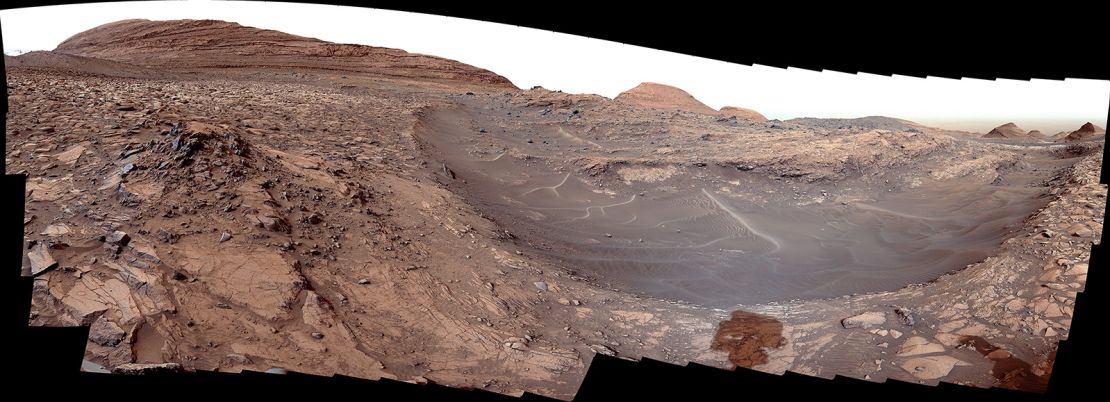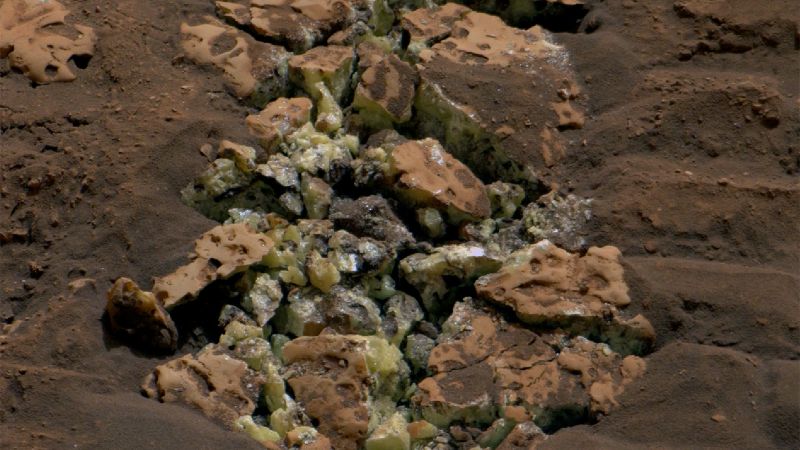Sign up for CNN’s Wonder Theory science newsletter. Explore space with news of fascinating discoveries, scientific advancements and more.
CNN
—
The Mars rover Curiosity has made its most unusual discovery yet: a rock made of pure sulfur. It all started when the one-ton rover accidentally ran over a rock, cracking it and revealing yellow-green crystals never before seen on the Red Planet.
“I think this is the strangest and most unexpected discovery of the mission,” said Ashwin Vasavada, Curiosity project scientist at NASA’s Jet Propulsion Laboratory in Pasadena, Calif. “I have to say there’s a lot of luck involved in this. Not every rock has something interesting in it.”
The Curiosity team was eager for the rover to explore the Gediz Canyon trench, a winding channel that’s thought to have been formed 3 billion years ago by the mixing of flowing water and sediment. The trench is carved into part of the 3-mile-high (5-kilometer-high) Mount Sharp, which the rover has been climbing since 2014.
Seeing the white rock in the distance, mission scientists wanted a closer look, so the rover’s drivers at the Jet Propulsion Laboratory, who direct Curiosity, rotated the robotic rover 90 degrees to put it in the right position for its cameras to capture a mosaic of the surrounding landscape.
On the morning of May 30, Vasavada and his team examined Curiosity’s mosaic and saw broken rocks lying among the wheel tracks. Photographing the rocks more closely revealed the “stunning” discovery, Vasavada said.
Some of Curiosity’s discoveries include: A lake that has existed for millions of years And that Presence of organic mattercontributed to the rover’s ultimate mission goal of determining whether a habitable environment exists on Mars.
Now scientists are on a mission to understand the significance of the presence of pure sulfur on Mars and what it tells us about the history of the Red Planet.
Curiosity had already found sulfates on Mars, salts containing sulfur that form when water evaporates. The team saw evidence of bright white calcium sulfate, also known as gypsum, in cracks on the Martian surface that are essentially hard-water deposits left behind by ancient groundwater flows.
“Nobody had pure sulfur on their bingo card,” Vasavada said.
Sulfur rocks typically have what Vasavada describes as a “beautiful, translucent, crystalline texture,” but weathering on Mars has essentially sandblasted the rock’s exterior, causing it to blend in with the rest of the planet, which is made up primarily of orange hues.
Team members were astounded twice, first when they saw the rock’s “incredible internal texture and color,” and then when they used Curiosity’s instruments to analyze the rock and received data showing it was pure sulfur, Vasavada said.
When we were exploring Mars, NASA’s Spirit rover The craft had to pull one wheel while reversing with the other five. The drag of the wheels revealed bright white soil that was almost pure silica. The presence of silica suggests that Mars once had hot springs and steam vents, which could have created favorable conditions for microorganisms if they existed on Mars.
The discovery of silica was one of the most important discoveries by the Spirit rover, which operated on Mars from 2004 to 2011. Vasavada said the discovery prompted the team to “look behind” the Curiosity rover, otherwise they would never have seen the crushed sulfur.
“When I saw the images of sulfur, my jaw almost dropped,” said Bryony Hogan, a professor of planetary science at Purdue University in West Lafayette, Indiana, and a co-investigator on the Perseverance rover mission. “It’s a really strange find because pure elemental sulfur is found on Earth primarily in places like hydrothermal vents — think Yellowstone — so it’s a big mystery to me how this rock formed on Mount Sharp.”
As it approached the Gediz Canyon strait, Curiosity transmitted back photos of an unusual sight: a flat area about half the size of a football field dotted with bright white rocks the size of a palm.
Initially, the team thought the “strange rocks” were part of a remnant waterway, perhaps a layer carried by water from higher up the mountain, Vasavada said.
But after further investigation, including the accidental crushing of the sulfur rocks, the team now believes a flat, uniform rock mass formed where the rocks were found, he said.
The team was eager to collect rock samples for study, but the rocks were too small and fragile for Curiosity to drill into. To determine what processes formed the sulfur rocks, the team instead looked at nearby bedrock.

Pure sulfur is produced on Earth only under certain conditions: volcanic activity, hot springs, cold springs, etc. Depending on the process, various minerals are produced at the same time as sulfur.
On June 18, the team retrieved a large rock from the waterway nicknamed “Mammoth Lakes.” An instrument on the rover’s belly analyzed the rock dust and found a greater variety of minerals than had been seen before during the mission, Vasavada said.
“The joke for us is that we found in this rock just about every mineral we’ve ever seen in the entire mission,” he said. “It’s pretty much a wealth of wealth.”
Since landing on Mars on August 5, 2012, the Curiosity rover has climbed 2,600 feet (800 meters) from the floor of Gale Crater to the base of Mount Sharp. The mountain is the central peak of a crater that is a vast, dry, ancient lake bed.
Each layer on Mount Sharp tells a different story about Mars’ history, including times when Mars was wet and times when it was dry.
Recently, Curiosity has been systematically studying various features on Mount Sharp, including the Gediz Canyon channel, which Vasavada says cut through different layers of Mount Sharp, meaning it formed long after the mountain’s collapse.
After the water and debris carved a path, it left a 2-mile (3.2-kilometer) ridge of rocks and sediment below the channel. Curiosity arrived at the channel in March and is expected to stay for another month or two, but it’s been steadily climbing along the debris trail for a while now.
Scientists had wondered whether the rocks were caused by floods or landslides, but Curiosity’s exploration found that both powerful water currents and landslides were likely involved. Some of the rocks are rounded like river rocks, suggesting they were transported by water, but others are more angular, meaning they were more likely transported by dry avalanches.
The water then seeped into the debris and a chemical reaction created the “halo” shape that is now visible in some of the rocks Curiosity examined.

“This has not been a quiet period on Mars,” Becky Williams, a scientist at the Planetary Science Institute in Tucson, Arizona, and deputy principal investigator for Curiosity’s Mast Camera, said in a statement. “There has been exciting activity here.”
We are observing multiple flows through the channel, including violent floods and rocky flows.”
Scientists are eager to uncover more details, including how much water was present that helped form the channel in the first place.
The Gediz Canyon Channel has long been of interest to scientists, including Vasavada, who recalls seeing orbital images of the feature long before Curiosity landed on Mars.
“That was always really interesting,” he said. “I remember “As the rover crested the last hill before reaching the channel, suddenly the terrain and the curving channel came into view. Now we’re actually here and seeing it with our own eyes, so to speak.”
There’s no conclusive evidence of how the sulfur formed, but researchers are continuing to analyze data collected by Curiosity to determine how and when each mineral formed.
“These rocks have probably been through several different environments,” Vasavada says, “and they’re all on top of each other, and we have to figure that out.”
Curiosity will continue exploring the waterway in search of more surprises, and after it moves, it will head west, following the mountain instead of going straight up, searching for more interesting geological features.
Despite the wear and tear over the 12 years, including several “close calls” such as wheel problems and mechanical issues, Curiosity remains in very good condition, Vasavada said.
“We feel very lucky, but we’re all wary that the next landing might just be a close call. So we’re trying to make the most of this opportunity, and we have this amazing landing site,” he said. “We’re pleased that we chose the culmination of 12 years’ worth of scientific research.”


